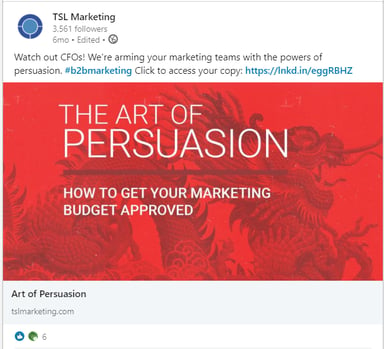LinkedIn Content Tips: Which Is Better, a Like, Share, or Comment?

March 18, 2024
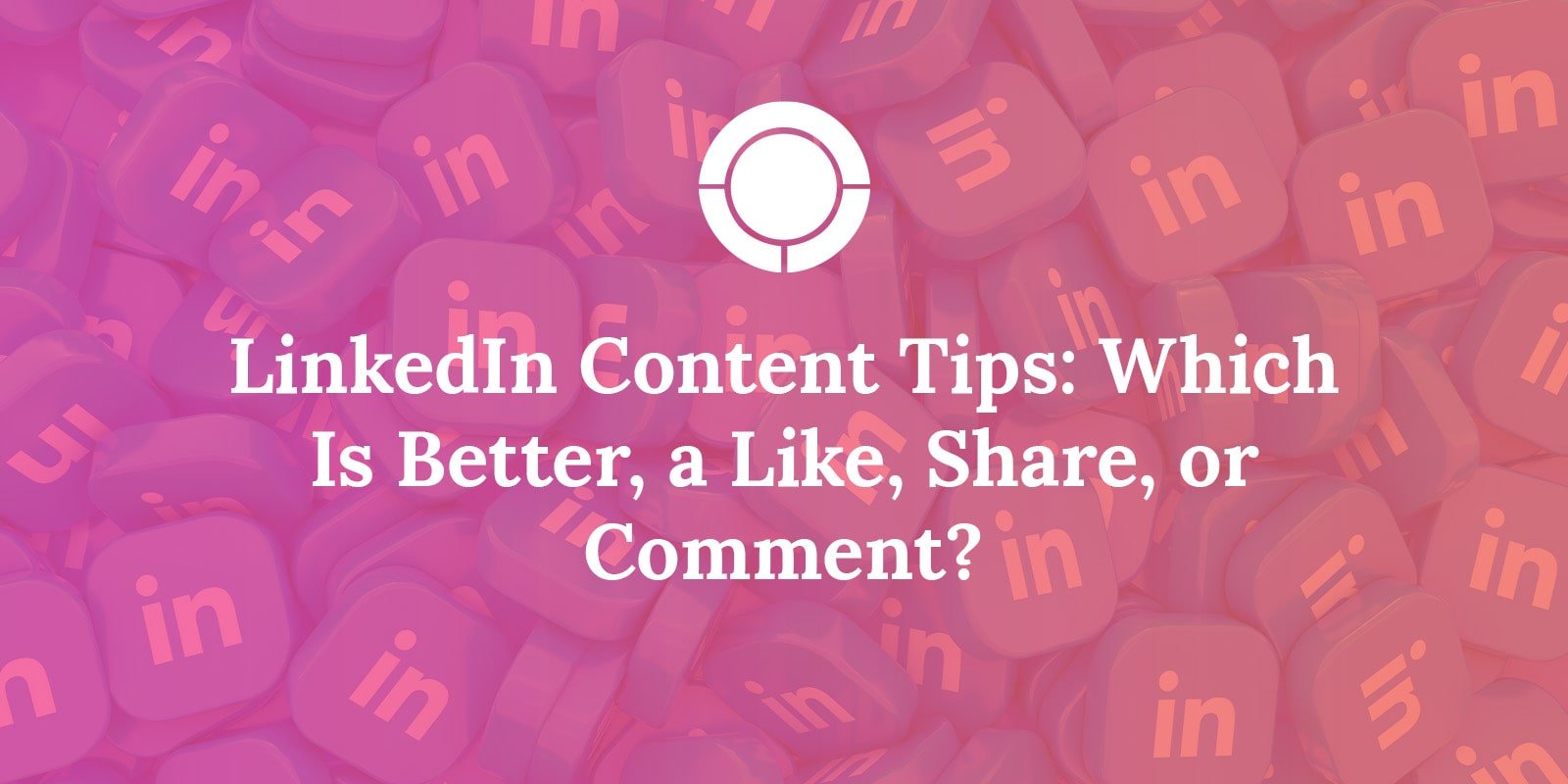
If your company is using social media as part of your B2B digital marketing mix, you should already understand the basic mechanics of how to like, share, and comment on LinkedIn content. However, you might wonder: “What is more valuable, a like, a share, or a comment, particularly as it relates to a company page post?”
The Algorithm Insights 2024 report emphasizes the importance of engagement, stating: “Engage. Don’t Post and Ghost. Stick around to mingle.”
What happens when you perform these actions? Is taking one action better than the other?
In this article we'll review what happens when you comment, like, and share on LinkedIn.
How Your LinkedIn Feed is Determined
In LinkedIn, content that generates discussion is preferred, and subsequently rewarded, by the professional social network platform.
This is why commenting is going to propel your post further and faster than a like or a share.
The most basic way to explain how your LinkedIn feed is determined is this: LinkedIn wants to show content to its users that is high-quality and applicable to their interests. Likes, shares, and comments act as signals to LinkedIn that content is good and relevant.
To understand how LinkedIn determines what's in your feed, check out the Hootsuite article "How Does the LinkedIn Algorithm Work."
Let's examine what likes, shares, and comments look like, how they're similar, and how they behave differently in your LinkedIn news feed.

To Like or to Share on LinkedIn
Let's take a quick dive into what happens when you like or share and how these actions signal to the LinkedIn algorithm that there’s something interesting to see, extending the reach of a post. We'll also take a quick look at emoji reactions.
LinkedIn Likes and Shares
One of the biggest differences between a like and a share is that, with a like, you are passing along your approval without comment. With a share, you can give your own comment and even @mention people you want to see the post.
Here is a great visual comparison:
Example of a LinkedIn Like
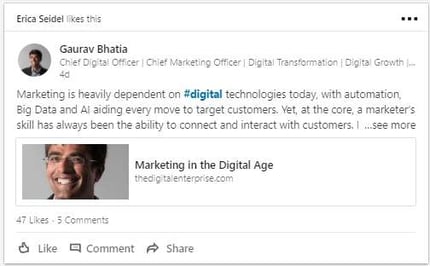
When you only like content, you don't have the ability to pass along any comments.
A big advantage when liking, especially for the original post, is that a liked post will pass along the social activity of the original post. Your connections who like the post that you liked will be adding a like to the original content. (Note the 47 likes on the above liked post versus the 3 likes on the shared post below.)
Example of a LinkedIn Share
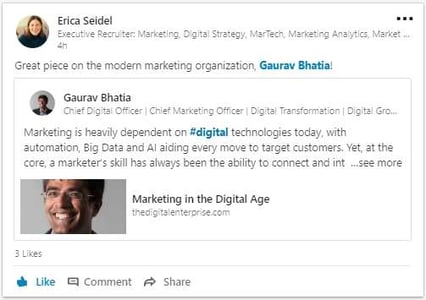
As you can see, liked and shared posts appear similar. But in the share, a comment is passed along with the post. This allows the person sharing to @mention someone, such as in the example above, in which the author of the piece receives a shout-out.
Sharing a post also lets you add your thoughts on the article that you're sharing, such as why someone should read the article, your general opinion on the piece, why you found it helpful, etc.
Reacting on LinkedIn with Emojis
Emojis provide more expressive ways than a like to respond to posts. Originally, LinkedIn created reaction emojis based on the most common 1 to 2-word comments being used on the platform.
Posters can use these reactions to better gauge the impact their posts are having on their social community.
Which reaction a user chooses doesn’t matter because the LinkedIn algorithm gives them equal weight and only cares that someone interacted with the post.
In the TSL Marketing post below, you can see where 6 readers that felt a post about a marketing strategy eBook deserved more than a like gave their approval through the celebrate emoji.
LinkedIn Comments
The popularity of a post could be defined by the amount of time people spend interacting with it, and nothing proves this more than a long thread of comments underneath a post.
While leaving a comment takes much more effort than hitting the Share button, commenting yields big payoffs.
Posts are sorted based on what the LinkedIn algorithm thinks is most relevant, so adding valuable, thought-provoking commentary can help position the post at the top of the list.
Comments can include thanking the user for sharing or asking them a question, but lengthier comments add even more value to the conversation.
Comments also benefit the commenter. For example, when you comment on a post generated by your company or shared by a co-worker, you have a chance to show off your knowledge and experience related to the topic, positioning yourself as an expert in your subject matter. The approach can lead to making new connections through the value of your comments.
Some tips for commenting:
- Add your opinion on the post topic
- Mention relevant experiences and facts
- Bring relevant people into the discussion with tagging
- Include bonus links or screenshots that give readers more information
For best results, keep the conversation going. Below, you can see how our team used commenting to generate interest in a case study that detailed the marketing journey of one of our MSP clients.
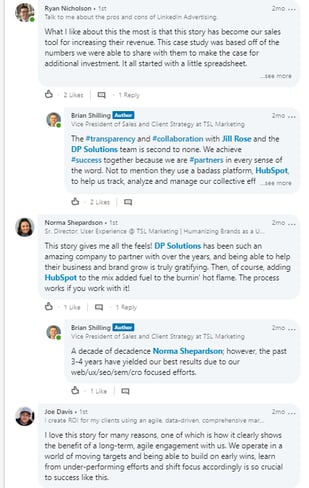
To Like, Share, or Comment?
So, which is better? Hands down, comments dominate the LinkedIn algorithm, making commenting alone superior even to likes and shares combined.
Comments provide more data than likes and re-shares and promote engagement. That’s why many successful posts end with a question. Questions prompt discussions.
However all 3 actions are instrumental in extending your marketing reach. We encourage the TSL Marketing team to like, share, and comment on any content that we're trying to promote on LinkedIn.
All 3 activities send social signals to the LinkedIn algorithm that the content has passed at least one user's approval. But these actions shouldn’t be taken just for the algorithm — the people seeing the liked and shared posts and comments will see social media proof that the content being passed along was deemed worthy by at least one of their network connections.
Want your content to get further faster? Learn more about TSL Marketing’s B2B Digital Advertising Services.

